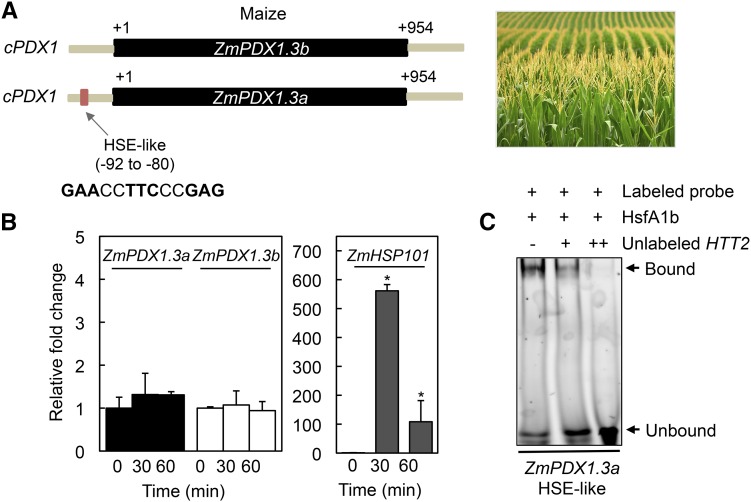Figure 4.
The catalytic PDX1s of maize do not respond to heat stress despite the presence of an HSE. A, Schematic representation of the catalytic PDX1s (cPDX1; ZmPDX1.3a and ZmPDX1.3b) present in maize, highlighting the HSE in ZmPDX1.3a. The single exon in each case is depicted in black and fragments of the respective upstream and downstream regions in gray. The numbers depict distance in bp from the translational start site (+1). B, Quantitative analysis of ZmPDX1.3a, ZmPDX1.3b, and ZmHSP101 expression in maize (cv Golden Bantam). The fold-change is depicted relative to before heat stress (time 0, set to 1) and after 30-min and 60-min exposure to 45°C for 1 h. Four-day-old seedlings precultivated at 28°C under continuous light (100–150 μmol photons m−2 s−1) were used. Statistical significance was calculated from a pairwise comparison to time 0, indicated by an asterisk for P < 0.001. In all cases, error bars represent se. C, EMSA of Arabidopsis HSFA1b binding to the HSE in the promoter of ZmPDX1.3a. A TAMRA-labeled double-stranded probe (50 nm, promoter fragment −99 to −60; Supplemental Table S2) was incubated with (+) purified AtHSFA1b (3 μm). An unlabeled probe of a fragment comprising the HSE of the Arabidopsis HTT2 promoter (either absent [−] or at two different concentrations + [0.2 μm] and ++ [2 μm], respectively) was used as a competitor of ZmPDX1.3a HSE binding to HSFA1b. Binding reactions were resolved on 5% native polyacrylamide gels.

